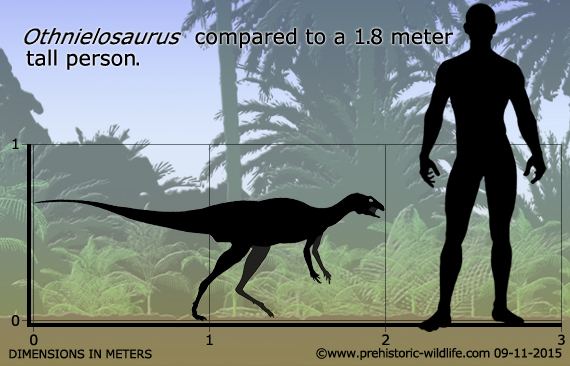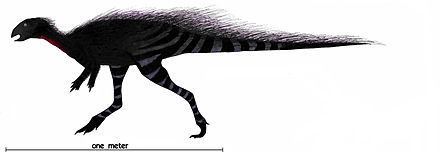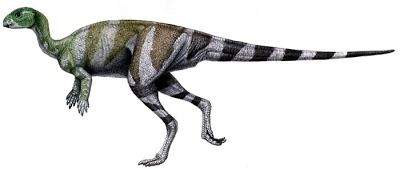Kingdom Animalia Clade Dinosauria Clade †Neornithischia Phylum Chordata Order Ornithischia | Class Reptilia Clade †Genasauria Species †O. consors Rank Genus | |
 | ||
Similar Othnielia, Hexinlusaurus, Laosaurus, Eocursor, Nanosaurus | ||
Othnielosaurus is a genus of ornithischian dinosaur that lived about 155 to 148 million years ago, during the Late Jurassic-age Morrison Formation of the western United States. It is named in honor of famed paleontologist Othniel Charles Marsh, and was formerly assigned to the genus Laosaurus. This genus was coined to hold fossils formerly included in Othnielia, which is based on remains that may be too sparse to hold a name; as such, it is part of decades of research to untangle the taxonomy left behind by Marsh and his rival Edward Drinker Cope from the Bone Wars. Othnielosaurus has usually been classified as a hypsilophodont, a type of generalized small bipedal herbivore or omnivore, although recent research has called this and the existence of a distinct group of hypsilophodonts into question.
Contents
- DescriptionEdit
- ClassificationEdit
- History and taxonomyEdit
- Paleobiology and paleoecologyEdit
- References

DescriptionEdit

Othnielosaurus is known from material from all parts of the body, including two good skeletons, although the skull is still poorly known (note that earlier references use a multitude of names for this material, with most of them since 1977 using Othnielia rex). Othnielosaurus was a small animal, 2 meters (6.6 ft) or less in length and 10 kilograms (22 lb) or less in weight. It was a bipedal dinosaur with short forelimbs and long hindlimbs with large processes for muscle attachments. The hands were short and broad with short fingers. From the partial type skull and the skull on the possible specimen "Barbara", the head was small. It had small leaf-shaped cheek teeth (triangular and with small ridges and denticles lining the front and back edges), and premaxillary teeth with less ornamentation. Like several hypsilophodont or iguanodont-grade ornithopods such as Hypsilophodon, Thescelosaurus, and Talenkauen, Othnielosaurus had thin plates lying along the ribs. Called intercostal plates, these structures were cartilaginous in origin.
ClassificationEdit

Othnielosaurus (previously under the names Laosaurus, Nanosaurus, and Othnielia) has typically been regarded as a hypsilophodont ornithopod, a member of a nebulous and poorly defined group of small, running herbivorous dinosaurs. This was challenged by Robert Bakker et al. in 1990. In their description of the new taxon Drinker nisti, they split Othnielia into two species (O. rex and O. consors) and placed "othnieliids" as more basal than hypsilophodontids. With recent analyses suggesting a paraphyletic Hypsilophodontidae, the general idea of "othnielids" as basal to other hypsilophodonts has been supported, although Drinker has been controversial because virtually nothing new has been published on it since its description. Other basal ornithopods have sometimes been linked to Othnielosaurus, particularly Hexinlusaurus, considered by at least one author to be a species of "Othnielia", O. multidens. New studies concur with the hypothesis that Othnielosaurus is more basal than other traditional hypsilophodonts, but go even farther and remove the genus from Ornithopoda and the larger group Cerapoda, which also includes Ceratopsians and pachycephalosaurs.
History and taxonomyEdit

O.C. Marsh named several species and genera in the late 19th century that have come to be recognized as hypsilophodonts or hypsilophodont-like animals, including Nanosaurus agilis (possibly), "N." rex, Laosaurus celer, L. consors, and L. gracilis. This taxonomy has become very complicated, with numerous attempts at revision in the years since.

In 1877, Marsh named two species of Nanosaurus in separate publications, based on partial remains from the Morrison Formation of Garden Park, Colorado. One paper described N. agilis, based on YPM 1913, with remains including impressions of a dentary, and postcranial bits including an ilium, thigh bones, shin bones, and a fibula. The other paper named N. rex, a second species which Marsh based on YPM 1915 (also called 1925 in Galton, 2007), a complete thigh bone. He regarded both species as small ("fox-sized") animals. He assigned this genus to the now-abandoned family Nanosauridae.
The next year, he named the new genus Laosaurus on material collected by Samuel Wendell Williston from Como Bluff, Wyoming. Two species were named: the type species L. celer, based on parts of eleven vertebrae (YPM 1875); and the "smaller" L. gracilis, originally based on a back vertebra's centrum, a caudal centrum, and part of an ulna (review by Peter Galton in 1983 finds the specimen to now consist of thirteen back and eight caudal centra, and portions of both hindlimbs).
A third species, L. consors, was established by Marsh in 1894 for YPM 1882, which consists of most of one articulated skeleton and part of at least one other individual. The skull was only partially preserved, and the fact that the vertebrae were represented only by centra suggests a partially grown individual. Galton (1983) notes that much of the current mounted skeleton was restored in plaster, or had paint applied.
These animals attracted little professional attention until the 1970s and 1980s, when Peter Galton reviewed many the "hypsilophodonts" in a series of papers. In 1973, he and Jim Jensen described a partial skeleton (BYU ESM 163 as of Galton, 2007) missing the head, hands, and tail as Nanosaurus (?) rex, which had been damaged by other collectors prior to description. By 1977, he had determined that Nanosaurus agilis was quite different from N. rex and the new skeleton, and coined Othnielia for N. rex. The 1977 reference, somewhat buried in a paper concerning the transcontinental species of Dryosaurus, did not elaborate, but did assign Laosaurus consors and L. gracilis to the new genus, and considered L. celer a nomen nudum. The publication of Drinker further complicated matters.
Most recently, in 2007 Galton reevaluated Morrison Formation ornithischians and concluded that the femur on which "Nanosaurus" rex (and by extension Othnielia) is based is not diagnostic, and reassigned the BYU skeleton to Laosaurus consors, which is based on more diagnostic material. As the genus Laosaurus is also based on nondiagnostic material, he gave the species L. consors its own genus, Othnielosaurus. As a result, in practical terms, what had been thought of as Othnielia is now known as Othnielosaurus consors. Othnielia is not a synonym of Othnielosaurus, because they are based on different specimens; however, the skeletons that had been used to describe and depict Othnielia were reassigned to Othnielosaurus, leaving the older name with only the original femur. The current status for the various species is as follows: Nanosaurus agilis is a possible basal ornithopod, "N." rex (Othnielia) is a dubious basal ornithopod, Drinker nisti is its own tentatively valid taxon, L. consors is the type species for Othnielosaurus, and L. celer and L. gracilis are still considered dubious.
Paleobiology and paleoecologyEdit
Othnielosaurus was one of the smaller members of the diverse Morrison Formation dinosaur fauna, diminutive in comparison to the giant sauropods. The Morrison Formation is interpreted as a semiarid environment with distinct wet and dry seasons, and flat floodplains. Vegetation varied from river-lining gallery forests of conifers, tree ferns, and ferns, to fern savannas with rare trees. It has been a rich fossil hunting ground, holding fossils of green algae, fungi, mosses, horsetails, ferns, cycads, ginkgoes, and several families of conifers. Other fossils discovered include bivalves, snails, ray-finned fishes, frogs, salamanders, turtles, sphenodonts, lizards, terrestrial and aquatic crocodylomorphans, several species of pterosaur, numerous dinosaur species, and early mammals such as docodonts, multituberculates, symmetrodonts, and triconodonts. Such dinosaurs as the theropods Ceratosaurus, Allosaurus, Ornitholestes, and Torvosaurus, the sauropods Apatosaurus, Brachiosaurus, Camarasaurus, and Diplodocus, and the ornithischians Camptosaurus, Dryosaurus, and Stegosaurus are known from the Morrison. Othnielosaurus is present in stratigraphic zones 2-5.
Typically, Othnielosaurus has been interpreted like other hypsilophodonts as a small, swift herbivore, although Bakker (1986) interpreted the possibly related Nanosaurus as an omnivore. This idea has had some unofficial support, but little in the formal literature; description of more complete skull remains will be needed to test this hypothesis.
